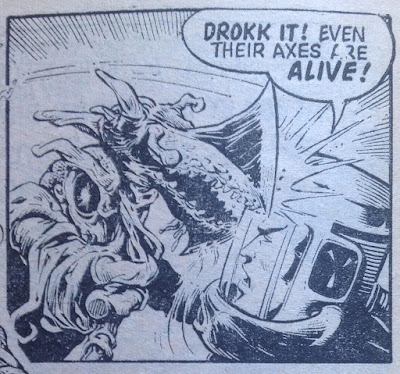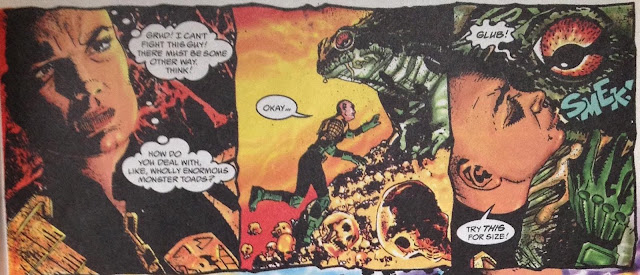First Prog: 1
Final Prog: 404
Total appearances: 181
- including 90 as a
script droid, and 91 as sub-editor / editor
Creator credits:
Project: Overkill
The Lawless Touch
(from Tornado)
-and he had not a
small hand in the very creation of both 2000 AD and StarLord
-and perhaps it’s he
who coined the word drokk?
 |
| Dare utters the word 'drokk' many times in his frist series. Art by Massimo Belardinelli |
Other writing credits:
Judge Dredd
Flesh
Blackhawk
adaptations of Harry
Harrison’s the Stainless Steel Rat
Lots and lots of
one-off twisty tales
Notable character creations:
Joe Black
Johnny Lawless (he must be notable - he got his own introductory cover!)
 |
| Art by Barry Mitchell |
Notable characteristics:
Selfish,
money-grabbing, lazy heroes. Setting up challenges in his plots that the heroes
solve through a combination of quick wits, bluffing and good old fashioned
luck.
On Kelvin:
Pat Mills, godfather
and mastermind of 2000AD, has always been quick to apportion credit to Kelvin
Gosnell for coming up with the idea of doing a Sci-Fi action comic for boys.
Specifically, it appears he spotted in advance that Star Wars was going to be
massive, and that people were going to want more of that sort of thing. Executives
were persuaded, Mills was cajoled into bringing the comic to actual life, and
thus AD2000 was born.
 |
| The originsl dummy cover for the comic that would go on to become, of course, 2000AD Art by ? Designer Doug Church, maybe? |
Perhaps as a reward
for all this, Mills got Gosnell on board as the scripter for the first run of
the new adventures of Dan Dare, the
most Star Wars-like of the first wave of strips in the comic. And Gosnell then
took over from Mills as the editor on the comic for the bulk of its first year,
covering Progs 17-85. He only stopped because he had ambitions to copy and
improve upon the 20000 AD model by setting up and then editing all 22 issues of
StarLord – the comic that birthed Strontium Dog and Ro-Busters.
 |
| Was the run of 22 issues of StarLord better than Progs 64-85? Art on this cover by Ramon Sola |
So unquestionably,
Gosnell was a key player in the foundation and early success of our favourite
comic. I struggle to speak to his editorial style, but I guess he’d have been
involved in decisions such as trying out a new style for Dan Dare, and choosing when / how to finish off Invasion, and MACH One, making room for the likes of RoboHunter.
He also deserves a
measure of credit for helping out the early comics career of Alan Grant, who
started off as Gosnell’s sub-editor, then worked
with him to carry Blackhawk over from
Tornado (where he was a straight-up historical action hero) to 2000AD, where he
became a way-out space gladiator. The way Grant ells, his, Gosnell gave him
both practical advice and perhaps even confidence to turn his hand to writing a
comic script. See also Judge Dredd: Aggro
Dome, co-written by the pair, and a hugely rare non-Wagner Dredd story that
you absolutely can’t tell isn’t by John Wagner, it fits the series so well.
 |
| Was the script for this born during the tempestuos time sof the IPC strike? Art by Mike McMahon |
From that point on, Gosnell’s
credits move exclusively to the script droid box. He never quite hit it off
with a whole new series, aside from his masterful adaptations of three Stainless Steel Rat novels, but his many
one-offs were always delightful, and the tone he uses suggests that it was as
much his worldview as anyone else’s that informed the nascent 2000 AD.
Let’s look into that a
bit more, shall we? I suggested that the first Dan Dare run is the most Star Wars-y thing to appear in 2000AD.*
But this is only inasmuch as it features spaceships, space pirates and space
battles with alien weirdoes. Overall, Dan
Dare isn’t remotely like Star
Wars in tone. What it is is a
showcase for Gosnell’s fondness for sneering, no-nonsense gruff action heroics,
coupled with alarmingly over the top escapades that often involve harsh moral
choices. Dare, the good guy, is a sweary, anti-authoritarian dude right from the
start. Very specifically, this is the signal to us readers that we’re going to
be on his side. He does things his way, doesn’t worry overmuch about the
consequences, and he definitely won’t take a telling.
 |
| Dare don't care. Art by Massimo Belardinelli |
Pat Mills concocted
and wrote the opening episodes of most of the very early series in 2000AD,
including Dan Dare, but Gosnell will
have helped him out. He clearly has an affinity for this kind of ‘stick it to
the man’ character that Mills was so keen to be the template hero for the
comic, so I can’t help but imagine he and Mills had a fair amount of
constructive back and forth on this sort of thing.
Gosnell was also
called upon to write several of the middle episodes of Flesh book 1. Again, the tone of this strip is to root for the
‘heroes’ who are actively ignoring the orders of their superiors. This time
it’s a bit more obvious that there are morally sound reasons for doing so, but
it’s the laconic ‘I’m right and you’re wrong’ attitude that informs the likes
of Earl Regan. I also imagine that what Gosnell was really into were the
episodes that focus on dino-based carnage, complete with the screams of dying children
brats.
He was also one of a
handful of writers to have a go at scripting some very early Judge Dredd episodes, back when that
series was still trying to find its feet before John Wagner took over. He had a
pretty great handle on the basics of coming up with inventive future crimes,
coupled with the dirtbags who commit such crimes.
The Gosnell character
archetype is the lithe but dependable man’s man who knows how to do stuff for
himself, doesn’t waste time on emotions – unless it’s anger or greed – and is
pretty handy with his fists. Yup, it’s 70s action heroes all the way.
 |
| Earl Reagan is a man's man. Art by Boix, I think? Or else more glorious Sola |
And so we get Captain
Kenny Harris, pilot extraordinaire and eventual hero who busts the evils of Project: Overkill wide open. It’s not
the most fondly remembered of stories, perhaps, but I think it’s one of the
better one-off long stories to have run. Indeed, I wonder if it was Gosnell as
editor who first approved the idea of running 7-12 episode long stories that
were never meant to be part of a new, endless strip. Always something of a risk
if you end up with a 12-week run of a weak story (*cough*Colony
Earth!; Dry Run; Trash etc),
but more often than not these have been a dependable source of exciting new and
original stories for 2000AD.
 |
| Project: Overkill is a mountain? Art by Jesus Redondo |
Any, back to Kenny
Harris. Ostensibly an upright chap, he’s mostly motivated by a sense of
annoyance that he can’t remember what happened, and that his name as a good
pilot has been maligned. Yes, he wants to be sure that his passengers are all
safe, but you can sort of tell that it’s more personal than that.
 |
| Kenny Harris wants answers, goddamit! Art by Ian Gibson |
 |
| Gosnell's heros also have a strong sense of right and wrong. Art by Jesus Redondo |
It turns out that
there’s a popular character from the world of pulp SF novels who fits Gosnell
to a tee – slippery Jim DiGriz, the
Stainless Steel Rat. DiGriz is a thief, but an enormously honourable one, who goes to great lengths to only steal from peopple who can afford it, or who, arguably, deserve a comeuppance or two. In the first story, he's coerced into becomeing an agent for the equivalent of an interplanetary FBI, and spends the rest of his adventures carrying out clever missions to take down scumbags (starting with psycho-killer Angelina, who becomes his wife). DiGriz is all about quick wits, sharp tongues, and being handy in a fight.
 |
| Harrison's original prose isn't too far from this terse style, actually. Art by Carlos Ezquerra |
 |
| Angelina DiGriz - 2000AD's deadliest female? Art by Carlos Ezquerra |
Gosnell must have put a fair bit of effort into
securing the rights from author Harry Harrison to adapt his series for comics.
He certainly put a lot of effort into writing the scripts – the three books
Gosnell adapted are amongst the very best novel-to-comics works I’ve ever read.
 |
| This is how to turn prose into comics, folks Art by Carlos Ezquerra |
Vast swathes of credit
to series artist Carlos Ezquerra, of course, and indeed to Harrison,
who knows his way around an exciting, page-turning adventure that lends itself
to the pacing needs of a comic.
But yes, if there’s
one thing I’ll value from Gosnell above anything else, it’s the Stainless Steel
Rat series. So glad Rebellion managed to put out a collected volume! So sad to
think that there are another 8 or so books that could, in theory, get the same
treatment from Gosnell/Ezquerra, but presumably at this point never will.
 |
| One of DiGriz's more loathsome villains is about to get his comeuppance Art by Carlos Ezquerra |
This leaves us with
Gosnell’s other major contribution, Tharg’s
Future Shocks! History may or may not record if any one person had the
brainwave to insert these single-episode twisty tales into the staple line-up
of 2000AD stories, but since Gosnell was editor when they first went in, he’ll
get some of that credit. Writer Steve Moore likely deserves the biggest cheer
for showing everyone else how its done – although, frankly, the vast majority
of the early Future Shocks were not so great.
Gosnell himself wrote
plenty, including I think the very first ‘man trapped in a virtual reality
prison’ story. You know, the story that Tharg specifically tells all
submissions pile hopeful NOT to use!
 |
| Art by Colin Wilson |
 |
| Other clichés
perpetrated by Gosnell include the old ‘things are the way they are because alien beings are playing games’… Art by Kevin O'Neill |
I’m being unkind,
because Gosnell wrote some pretty great one-off tales, too, not least a series
of short stories featuring Joe Black, perhaps the first Future Shock protagonist to (almost) earn himself his own series. A
classic Gosnell rogue, Black has to use a combination of wits, luck and basic
mechanics skills to get what he wants out of life – peace, quiet and the promise
of enough cash to buy a beer.
 |
| Black wins by cheating. Art by John Higgins |
More on Kelvin Gosnell:
There's only a passing mention of Kelvin Gosnell himself in here, but this is a lengthy piece by Pat Mills about the genesis of Dan Dare's appearance in 2000AD
I believe it's noe out of print, but if you can get hold of a copy of Beyond 2000AD by Hibernia Press, you'll find some words from the man himself
Personal favourites:
Judge Dredd: The New You; Aggro Dome
Project: Overkill
The Stainless Steel Rat
Joe Black: Trial and Error; Horn of Plenty; the Hume Factor
The Art of Advertising
 |
| Art by Garry Leach |
*Later, post-Gosnell Dan Dare was more similar to Star Trek.
And in the decades since, other strips such as, hell, Junker or even Ace Trucking
Co were a bit more Star Wars-y, for the smuggling side of things, and I
guess Insurrection for the ‘rebels vs
evil Empire’ type stuff.










































